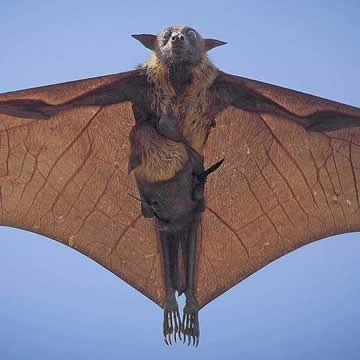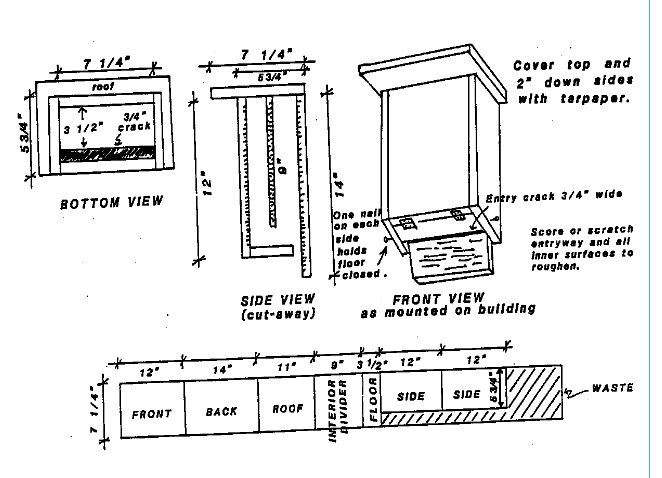Bat Houses
Bat houses can be purchased at many home and garden centers, or can be easily built in an afternoon, if you'd like a pre made bat house, we have many styles and types available on this site. . There are many how-to web sites, as well as free downloadable bat house plans available on the internet.
A bat house is much different than a bird house. Here is a list of the basic characteristics for bat houses:
- The opening for entrance and exit will not be at the front, but underneath. There should be a long open strip along the bottom. The entrance and the back wall of the bat house should be covered in a kind of mesh that the bats can climb with their claws.
- Bat houses are typically made of wood with grooves in the interior walls, since bats need a rough, graspable surface to hang from during the day. The best have roost chambers at least 20 inches tall and 14 inches wide, and a 3- to 6-inch landing area near the entrance. Pressure-treated wood isn't recommended. It's best to leave the inside unpainted, but consider exterior paint to keep the house warm.
- It should not be cube shaped but instead should be a very wide, fairly tall, flat box. Keep in mind that you are not making this house for a single bat or even a pair of bats. Bats will sleep in your house in groups of usually more than a dozen. According to those who have customized bat houses based upon studies of behavior, the smallest bat house should have exterior dimensions of roughly 13 1/2 inches wide, 3 3/4 inches deep, and 20 inches tall (with an additional 4 or 5 inches of the back wall extending below the floor to the entrance, providing something for the bats to latch on to).
- There should be several narrow open strips along the lower portions of the sides to vent air from the box. They often rest in densely packed groups, so the heat they generate and CO2 they release needs to be vented well. Ideally, you'll want to cut out notches in the front and sides to serve as ventilation slits before assembling the bat house.

- A common single-chamber bat house is capable of housing 50 bats, while a larger multi-chamber design can attract nursery colonies of 200 or more bats. Since bat houses have open bottoms to keep guano from collecting inside, don't place it directly above a window, door, deck or walkway. You could put a tray underneath to catch guano as fertilizer, but never use a bucket or other deep container — any baby bats that fall from their roost could get trapped inside.
- All ventilation slits should be made no larger than 1/4 of an inch. If too large, it could let too much cold air in and bat nurseries need to be warm. If the slits are 1/2 an inch in size or more, it would allow small birds to take over the house as a nesting area and the point is we want bats in the house, not birds.
- The roof should be long enough to extend from a position above the back wall to a place several inches beyond the front wall. It can be installed to meet the back and front walls at a 90 degree angle. If you want to roof to be at a 30 degree angle it will have to longer.
- Mount the bat house on a pole15 to 20 feet off the ground and away from electric lights, or on the side of a building. Tree-mounted homes are easily accessible to predators and tend to have too much shade. Bats need a certain amount of height to drop down before they catch flight, so the bat house must be high enough for them to fly away without being within reach of an animal snatching them as they take off. Avoid being too close to trees where owls or hawks may wait for a quick meal.
- Bats prefer warmer climates, and temperatures between 85-100° F. Face the bat home south to southeast—that way, when the sun rises, the bat house catches the heat and warms up. Roost temperature is probably the single most important factor for a successful bat house. The ideal temperature for mother bats to raise their young is between 80 and 100 degrees Fahrenheit (27 and 38 Celsius), although some species are more flexible than others. Once it's built and caulked, there are two main ways to control heat in a bat house: location and color. Place the house where it will get at least six hours of sunlight per day — facing south, east or southeast in most climates — and paint the outside a dark color to absorb heat. Observations suggest that color should be black where average high temperatures in July are less than 85° F, dark colors (such as dark brown or dark gray) where they are 85° to 95° F, medium colors where they are 95° to 100° F and white or light colors where they exceed 100° F. Much depends upon amount of sun exposure. Depending on climate, natural wood color may be dark enough to keep a bat house warm without painting it.
- You can set up a bat house any time of year, but spring and early summer are when prospective residents are most likely to visit. Be patient, and allow time for bats to discover and examine the house. If it's still unused after two years, try modifying or moving it. 90 percent of bat houses that attract bats do so within two years, while the other 10 percent take three to five years. And if you're evicting a bat colony from a building it might help to mount a bat house nearby several weeks ahead of time.
Returning bats
 Bats are loyal nesters returning year after year to the same place, putting up a bat house in an area they frequent is no guarantee they will use it. Solitary roosters (red, hoary and silver-haired bats) might ignore them, and one or two years might pass before the other species may find them.. In Michigan, little brown bats and big brown bats are the species most likely to use bat houses.
Bats are loyal nesters returning year after year to the same place, putting up a bat house in an area they frequent is no guarantee they will use it. Solitary roosters (red, hoary and silver-haired bats) might ignore them, and one or two years might pass before the other species may find them.. In Michigan, little brown bats and big brown bats are the species most likely to use bat houses.
The bat house provides a a safe place away from wind and rain, not to mention dangerous predators. Inspect it regularly from spring to early fall to make sure no bees or wasps have moved in. You'll know your bat home is a success and the bats have taken up residence and droppings begin appearing around the house on the ground.
People often build bat houses on their own, and you can find plans online from groups such as Bat Conservation International (BCI) or the National Wildlife Federation (NWF). Kits and pre-built bat houses are also sold online, we have a few here. Bats tend to be picky so it helps to find houses that have bat approved certification (they don't tell us who these bats are that do the certifying!)
Although some species hibernate in caves, bats tend to spend warmer months in trees. They seek the security of tight spaces such as the gaps between a tree's bark and its trunk. That's why the living area inside a bat house is so narrow, it is designed to mimic these spaces.. While bats prefer houses on poles or walls, they'll still occupy a tree-mounted house if it meets their other criteria. Bats investigate potential roosting opportunities while foraging at night and they are expert at detecting crevices, cracks, nooks and crannies that offer shelter from the elements and predators but are almost invisible to our eye.
Don't waste your time trying to entice them with bait, it doesn't work. Also catching them in one area and releasing in another is not likely to work due to their strong homing instincts.
Though spectacularly large colonies occupy a few well-known caves, the majority of caves do not have bats. Neither are most crevices and cavities in cliffs, rocks, and eroded banks occupied - bats are notoriously picky. Sometimes only one in hundreds or thousands of seemingly available roosts actually meets the bat's picky requirements (i.e., i food or water, required temperatures, and is safe from predators). And if your bats leave after taking up roost, it's not unusual. Sometimes they'll only use a roost for one season each year, or may return year after year.











